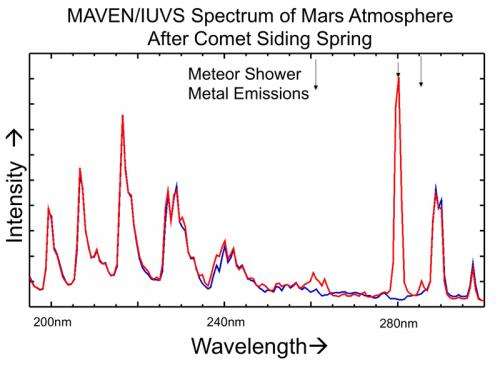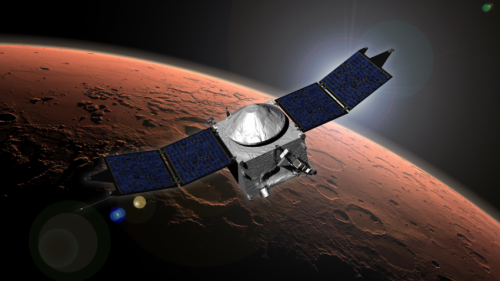Mars spacecraft reveal comet flyby effects on Martian atmosphere

Two NASA and one European spacecraft, including NASA's MAVEN mission led by the University of Colorado Boulder, have gathered new information about the basic properties of a wayward comet that buzzed by Mars Oct. 19, directly detecting its effects on the Martian atmosphere.
Data from observations carried out by MAVEN, NASA's Mars Reconnaissance Orbiter (MRO) and the European Space Agency's Mars Express spacecraft revealed that debris from the comet, known officially as Comet C/2013 A1 Siding Spring, caused an intense meteor shower and added a new layer of ions, or charged particles, to the ionosphere. The ionosphere is an electrically charged region in the atmosphere that reaches from about 75 miles (120 kilometers) to several hundred miles above the Martian surface.
Using the observations, scientists were able to make a direct connection between the input of debris from the meteor shower to the subsequent formation of the transient layer of ions - the first time such an event has been observed on any planet, including Earth, said the MAVEN research team.
The comet traveled from the most distant region of our solar system called the Oort Cloud and made a close approach at 2:27 p.m. EDT within about 87,000 miles (139,500 kilometers) of the Red Planet. That is less than half the distance between Earth and our moon and less than one-tenth the distance of any known comet flyby of Earth.
"MAVEN is well suited for studying the effects of the dust from the comet in the Martian atmosphere, because it makes measurements at the altitudes where the dust was expected to have an effect," said CU-Boulder Professor Bruce Jakosky of the Laboratory for Atmospheric and Space Physics, the principal investigator on the $671 million Mars Atmosphere and Volatile EvolutioN (MAVEN) mission. "We also should be able to see if there are long-term effects from the comet dust in that same region of the atmosphere."

Dust from the comet was vaporized high in the Martian atmosphere, producing what was likely an impressive meteor shower. The debris resulted in significant but temporary changes to the planet's upper atmosphere and possible longer-term changes. A host of Earth-based and orbiting telescopes also observed the unique celestial event.
The MAVEN spacecraft, recently arrived at Mars, detected the comet encounter in two ways. The remote-sensing Imaging Ultraviolet Spectrograph (IUVS) designed and built at CU-Boulder observed intense ultraviolet emissions from magnesium and iron ions high in the atmosphere in the aftermath of the meteor shower. Not even the most intense meteor storms on Earth have produced as strong a response as this one: The emission dominated Mars' ultraviolet spectrum for several hours after the encounter and then dissipated over the next two days, according to the MAVEN science team.
MAVEN also was able to directly sample and help scientists determine the composition of some of the vaporized comet dust in Mars' atmosphere. Analysis of these samples by the spacecraft's Neutral Gas and Ion Mass Spectrometer designed and developed at NASA Goddard Space Flight Center in Greenbelt, Maryland, detected eight different types of metal ions, including sodium, magnesium and iron.
These are the first direct measurements of the composition of dust from an Oort Cloud comet. The Oort Cloud, well beyond the outermost planets that surround our sun, is a spherical region of icy objects believed to be material left over from the formation of the solar system.

"They call this comet encounter a once-in-a-lifetime event, but it's more like once-in-a-million years," said CU-Boulder Associate Professor Nick Schneider, a LASP research associate and lead IUVS scientist for the mission. "MAVEN got there just in time, and we were ready. The numbers suggest a Martian would have seen many thousands of shooting stars per hour—possibly enough to be called a meteor storm—so it must have been a spectacular event that night on Mars."
Discover the latest in science, tech, and space with over 100,000 subscribers who rely on Phys.org for daily insights. Sign up for our free newsletter and get updates on breakthroughs, innovations, and research that matter—daily or weekly.
Elsewhere above Mars, a joint U.S. and Italian instrument on Mars Express observed a huge increase in the density of electrons in the Martian ionosphere following the comet's close approach.
"This historic event allowed us to observe the details of this fast moving Oort Cloud comet in a way never before possible using our existing Mars missions," said Jim Green, director of NASA's Planetary Science Division at the agency's headquarters in Washington. "Observing the effects on Mars of the comet's dust slamming into the upper atmosphere makes me very happy that we decided to put our spacecraft on the other side of Mars at the peak of the dust tail passage and out of harms way."
There are three CU-Boulder undergraduates and two graduate students on the IUVS science team, said Schneider, and there will be a number of additional CU-Boulder students working on MAVEN in the coming years. Currently there are more than 100 students working on research projects at LASP, which provides hands-on training for future careers as engineers and scientists.
In addition to leading science operations, CU-Boulder is spearheading education and public outreach for MAVEN mission, which has contributed roughly $300 million to Colorado's economy. UC-Berkeley's Space Sciences Laboratory provided four science instruments for the mission.
Provided by University of Colorado at Boulder





















